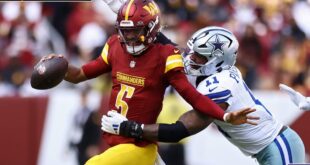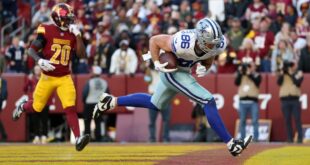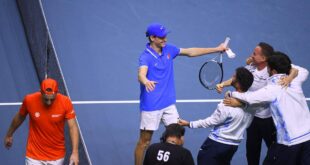This article is part of our Origin Stories series, an inside look at the backstories of the clubs, drivers, and people fueling the sport.
Zak Brown never grew up expecting to become one of the most powerful figures in Formula One.
He doesn’t come from a racing background, nor does he have a college degree. Motorsport wasn’t even his “first love.” It was baseball. At one point in his career, he was sleeping on an air mattress on the floor of a friend’s sister’s dining room in England, working for £75 a day.
Brown, born in Los Angeles, Calif., but considers himself British given how long he’s lived in the U.K., got his racing start thanks to winning during a Teen Week episode of one of the longest-running game shows on American television and some advice from Mario Andretti.
Now, Brown’s the CEO of McLaren Racing — and one of his teams leads the F1 constructors’ standings for the first time since 2014.
“I didn’t come from a racing background. I didn’t come from a privileged background. We weren’t poor, but by racing standards, we were poor,” Brown said to The Athletic. “And so I think I’ve been fortunate to get where I am because of a lot of help, a lot of luck, but also a lot of hard work. And I think what I’ve been fortunate to achieve can be replicated by others if you put in the time and effort and have the passion.”
“Wheel of Fortune” started as a daytime game show on NBC in 1975, created by Merv Griffin, who also designed “Jeopardy!”. Chuck Woolery and Susan Stafford were the original host duo before Pat Sajak and Vanna White joined in the early 1980s.
The now-evening game show is similar to the pencil-and-paper guessing game Hangman. Contestants spin a colorful wheel filled with possible prizes, like different cash amounts, and danger placards, such as “Lose A Turn” and “Bankrupt.” They then try to win by correctly guessing, letter-by-letter, what the answer is on the letterboard.
This iconic American show is where Brown began building his motorsports career.
He attended his first F1 race with his family in 1981 and became captivated by the cars, sound and speed. Although he “fell in love with racing,” he had no connections to the F1 world. “It seemed very unachievable,” he said, “and (I) didn’t even know how do you get in racing, where baseball is quite easy, because everybody plays it.”
His father continued to take him and his brother to local races, but baseball still gripped Brown’s attention until high school, when the sport became more serious. He couldn’t continue playing because he wasn’t attending school very frequently. He said, “You don’t get to stay on the baseball team if you don’t get good grades.”
Around this time, Brown finally had a racing connection: a friend’s family was involved in motorsports. But that world still did not seem attainable. He was still in love with America’s favorite pastime.
In 1984, the big game show came to town. Kids could apply and interview to compete on “Wheel of Fortune” for Teen Week. Brown recalls that around 50 to 75 students from each school came in for “a dummy hangman contest, do a little interview to see if they thought you can handle being on TV, et cetera.” From there, they whittled the number per high school to 15. The top 15 finalists from each high school then underwent more “testing and simulated games,” ending with a waiting period. “We’ll call you. Don’t call us, and we might not call you,” Brown recalls.
As a lifelong fan of the show, Brown eagerly navigated the process (and waiting game). The call came a week later — he had made it. “Wheel of Fortune” brought 20 kids back, taping a whole week of shows in a single day. But there was a twist: only 15 teens could be on the show.
“They need 15 people, but you can get disqualified if you talk to the audience or do something you shouldn’t,” Brown said. “So even though you now know you’re in the top 20 and you’re actually going to go to the recording, you don’t know if you were one of the 15 or one of the five subs.”
He was one of the 15 contestants and behaved — and he won the first two rounds. “The Smurfs and Wild Bill Hickok, who I had no idea who that was.”
For those familiar with today’s “Wheel of Fortune,” you know the contestants win money or sometimes a vacation. But when Brown played on Teen Week, they selected prizes. A carousel of sorts with prizes would spin, and the contestants were put on the spot to select their winnings.
“They show this big whiteboard, and everything’s listed in the order of cost, and they would knock out what you can’t afford,” Brown said. “And so, as most 13-year-olds, the first thing you do is look at the board and just go, what’s the most expensive thing I can afford? It had to be watches.”
The watches sat around in his house for some time, the intention being to sell them at some point. A motorsports career was so far from his mind that when Sajak asked on the show what he wanted to do, Brown referred back to his favorite sport.
“Baseball player.”
A few years went by, and the watches still hadn’t been sold.
Brown attended the Long Beach Grand Prix in 1987, and one of his friend’s families happened to know Andretti, who won the F1 world championship in 1978. He met Andretti that race weekend and asked him a question that shaped the next chapter of his life—“How do you get started in racing?”
Andretti’s answer was karting. Inside the race program, there happened to be an advertisement for a kart racing school. Brown went on to sell the watches he won on “Wheel of Fortune” at a pawn shop in Van Nuys, a neighborhood in Los Angeles, Calif. He used that money to pay for the kart racing school and loved it.
Brown began advancing and winning in karting, competing for almost five years in California before making the jump to Europe in 1991, though it was not a permanent move. In 1984, he competed in both British Formula Three and the Formula Opel-Lotus Benelux Series as well as North America’s Toyota Atlantic Series. The following year, he made his Indy Lights debut and launched his own company, Just Marketing Inc.
“When I was racing in Europe, ’91 through ’94, TWA Airlines was my big sponsor. I was kind of getting homesick, and I got a deal to race back in the States. So I went to TWA and said, ‘Hey, I’m out of here. I’m going to go race back in the States.’ And at that point, the sponsorship became very successful for them. So they said, ‘That’s a shame you’re leaving. But you must know all the guys and gals in pit lane. Can you place your sponsorship with someone?’”
Brown agreed and took a commission after placing the sponsorship. He realized, “Not only should I be chasing sponsorship for myself, but actually, it’s much easier to sell some of the more famous people out there.” Brown had spent years networking and building relationships, and he asked his contacts about expanding their sponsorships to various motorsports series, like IndyCar, NASCAR and F1.
“Because they trusted me and I had credibility, that I knew what I was doing from the racing side, people started going, actually, yeah, we don’t want to sponsor you, Zak, because you’re not famous enough. But if you can go get us in front of Jeff Gordon or Nigel Mansell, we’d be interested. And that’s how the business got started.”
His business grew along with his reputation to get sponsorship deals done. But he needed help. Brown hired his first employee and created the business’s name — Just Marketing Inc. Brown said he didn’t want his name on the company, and he wanted “a little bit of intrigue,” so he opted against including motorsports. To this day, he still calls Just Marketing “kind of a crazy name.”

Zak Brown drove in the Legends Parade during the 2024 Austrian GP weekend. (JOHANN GRODER/APA/AFP via Getty Images)
Brown couldn’t keep pursuing a full-time racing career, though he still hops into a car from time to time and co-founded United Autosports with racing driver Richard Dean in 2009. However, Brown continued to thrive in the business industry as he grew his skills and knowledge of motorsports’ commercial and business worlds. JMI became one of the largest motorsport marketing agencies worldwide when Brown sold a majority of it in 2008. Seventy percent of the company went to Spire Capital and Credit Suisse.
Chime Communications bought JMI in 2013 and brought Brown in as Group CEO for three years, which he said was “about two years and 11 months longer than I would have liked.” The role focused on a variety of sports, but he loves baseball, hockey and racing.
“I was getting involved in sports that have no passion for me, and I’ve always been driven,” Brown continued. “My work ethic’s always been driven by fun and passion. And so when I was getting involved in other sports that don’t tick that box, I felt like I had a job.”
At the end of 2016, he had a choice — work for F1 or McLaren. He ultimately decided to go with the papaya family, joining in 2017 as its CEO at a time when McLaren was in the midfield (finishing sixth in 2016). He not only helped transform the brand of the F1 team but also took the company to a global level, the most recent chapter being the World Endurance Championship this year.
“It was always my favorite racing team, and I wanted to be not only on the commercial side of the business, which I loved, but I wanted to be on the competitive side of the business,” Brown said. “So that was something that McLaren could offer me, that Formula One as a sanctioning body couldn’t.”
The same characteristics F1 fans see today have been evident throughout each of Brown’s chapters. Passion has been at the core of his work ethic, and he does not shy away from showing excitement like he did at 13 years old while standing on the “Wheel of Fortune” stage.
But to think, the story of a prominent F1 leader started thanks to a multicolored wheel, a Hangman-esque game and watches he sold to a pawn shop.
The Athletic maintains full editorial independence. Partners have no control over or input into the reporting or editing process and do not review stories before publication.
Top photo: Clive Mason/Getty Images
Source link
 meganwoolsey Home
meganwoolsey Home



